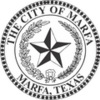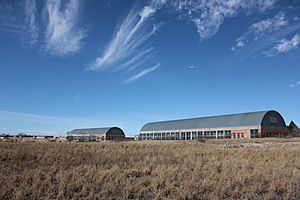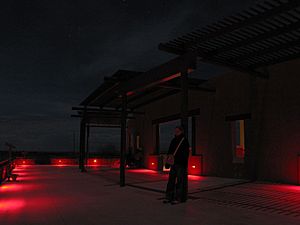Marfa, Texas facts for kids
Quick facts for kids
Marfa, Texas
|
||
|---|---|---|
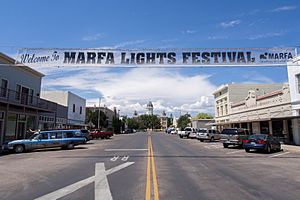
Downtown Marfa
|
||
|
||
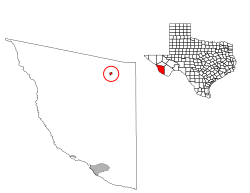
Location of Marfa in Presidio County
|
||
| Country | ||
| State | ||
| County | Presidio | |
| Named for | Marfa Strogoff, a character in the novel Michael Strogoff | |
| Area | ||
| • Total | 1.63 sq mi (4.22 km2) | |
| • Land | 1.63 sq mi (4.22 km2) | |
| • Water | 0.00 sq mi (0.00 km2) | |
| Elevation | 4,698 ft (1,432 m) | |
| Population
(2020)
|
||
| • Total | 1,788 | |
| • Density | 998/sq mi (385/km2) | |
| Demonym(s) | Marfan | |
| Time zone | UTC-6 (Central (CST)) | |
| • Summer (DST) | UTC-5 (CDT) | |
| ZIP code |
79843
|
|
| Area code | 432 | |
| FIPS code | 48-46620 | |
| GNIS feature ID | 2411031 | |
Marfa is a small city located in the high desert of West Texas, United States. It sits between the Davis Mountains and Big Bend National Park, about 4,685 feet above sea level. Marfa is the main town, or county seat, of Presidio County.
The city was started in the early 1880s. It began as a water stop for trains. Marfa's population was largest in the 1930s. In 2020, about 1,788 people lived there. Today, Marfa is a popular place for tourists. It is also a big center for minimalist art. Some famous spots include Building 98, the Chinati Foundation, and the mysterious Marfa lights.
Contents
Marfa's Story: A Look at Its History
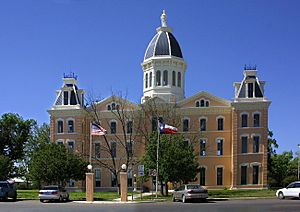
Marfa was founded in the early 1880s. It started as a place where trains could stop for water. The town got its name, "Marfa," from the wife of a railroad boss. She suggested the name, which is Russian for "Martha."
Some people thought the name came from a character in a book called The Brothers Karamazov. But it was actually named after Marfa Strogoff, a character in Jules Verne's novel Michael Strogoff. A writer looked into the story and found the Karamazov idea was wrong. But nobody seemed to mind. The story they had about the name was good enough for Marfa.
The town grew quickly in the 1920s.
Marfa During World War II
The Marfa Army Air Field was a training place during World War II. Thousands of pilots learned there, including the actor Robert Sterling. The base also trained many U.S. Army chemical mortar groups. It closed in 1945.
Art and Growth in Marfa
After the war, Marfa faced money problems. A drought also hurt farming. Then, in 1973, an artist named Donald Judd moved to Marfa from New York. He started buying and fixing up old buildings. This made other artists interested in the town.
In 2012, Vanity Fair magazine called Marfa a "playground" for artists. It became a place where art pioneers and visitors came to see art. Marfa is about 60 miles from the Mexico-U.S. border.
Marfa's Location and Weather
Marfa is in the northeastern part of Presidio County. It is located within the Chihuahuan Desert. The town is about 20 miles south of Fort Davis. It's also about 18 miles west of Alpine. The city covers about 1.6 square miles of land.
Marfa's Climate
Marfa has a semi-arid climate. This means it has hot summers and cool winters. Because it's high up and dry, the temperature can change a lot between day and night.
| Climate data for Marfa #2, Texas. (Elevation 4,790ft) | |||||||||||||
|---|---|---|---|---|---|---|---|---|---|---|---|---|---|
| Month | Jan | Feb | Mar | Apr | May | Jun | Jul | Aug | Sep | Oct | Nov | Dec | Year |
| Record high °F (°C) | 81 (27) |
86 (30) |
90 (32) |
96 (36) |
102 (39) |
106 (41) |
103 (39) |
104 (40) |
100 (38) |
95 (35) |
86 (30) |
79 (26) |
106 (41) |
| Mean daily maximum °F (°C) | 60.2 (15.7) |
63.9 (17.7) |
71.2 (21.8) |
78.8 (26.0) |
85.8 (29.9) |
91.2 (32.9) |
89.6 (32.0) |
87.5 (30.8) |
83.6 (28.7) |
77.3 (25.2) |
67.6 (19.8) |
60.8 (16.0) |
76.5 (24.7) |
| Daily mean °F (°C) | 42.9 (6.1) |
46.0 (7.8) |
52.3 (11.3) |
60.1 (15.6) |
67.9 (19.9) |
74.4 (23.6) |
74.9 (23.8) |
73.3 (22.9) |
68.7 (20.4) |
60.7 (15.9) |
50.5 (10.3) |
43.7 (6.5) |
59.6 (15.3) |
| Mean daily minimum °F (°C) | 25.7 (−3.5) |
28.1 (−2.2) |
33.5 (0.8) |
41.4 (5.2) |
50.1 (10.1) |
57.6 (14.2) |
60.2 (15.7) |
59.1 (15.1) |
54.0 (12.2) |
44.1 (6.7) |
33.4 (0.8) |
26.6 (−3.0) |
42.8 (6.0) |
| Record low °F (°C) | −2 (−19) |
0 (−18) |
6 (−14) |
17 (−8) |
27 (−3) |
39 (4) |
53 (12) |
50 (10) |
36 (2) |
16 (−9) |
−1 (−18) |
2 (−17) |
−2 (−19) |
| Average precipitation inches (mm) | 0.42 (11) |
0.47 (12) |
0.31 (7.9) |
0.59 (15) |
1.17 (30) |
1.78 (45) |
2.73 (69) |
2.89 (73) |
2.57 (65) |
1.39 (35) |
0.58 (15) |
0.50 (13) |
15.41 (391) |
| Average snowfall inches (cm) | 0.7 (1.8) |
0.6 (1.5) |
0.1 (0.25) |
0.0 (0.0) |
0.0 (0.0) |
0.0 (0.0) |
0.0 (0.0) |
0.0 (0.0) |
0.0 (0.0) |
0.0 (0.0) |
0.4 (1.0) |
0.4 (1.0) |
2.2 (5.6) |
| Average precipitation days (≥ 0.01 in) | 3 | 3 | 2 | 3 | 5 | 7 | 9 | 10 | 8 | 5 | 3 | 3 | 59 |
| Source: Western Regional Climate Center, Desert Research Institute | |||||||||||||
Marfa's People: Demographics
| Historical population | |||
|---|---|---|---|
| Census | Pop. | %± | |
| 1920 | 3,553 | — | |
| 1930 | 3,909 | 10.0% | |
| 1940 | 3,805 | −2.7% | |
| 1950 | 3,603 | −5.3% | |
| 1960 | 2,799 | −22.3% | |
| 1970 | 2,647 | −5.4% | |
| 1980 | 2,466 | −6.8% | |
| 1990 | 2,424 | −1.7% | |
| 2000 | 2,121 | −12.5% | |
| 2010 | 1,981 | −6.6% | |
| 2020 | 1,788 | −9.7% | |
| U.S. Decennial Census | |||
2020 Census Information
In 2020, the United States census counted 1,788 people living in Marfa. There were 802 households and 300 families.
| Race | Number | Percentage |
|---|---|---|
| White (NH) | 678 | 37.92% |
| Black or African American (NH) | 13 | 0.73% |
| Native American or Alaska Native (NH) | 4 | 0.22% |
| Asian (NH) | 12 | 0.67% |
| Some Other Race (NH) | 2 | 0.11% |
| Mixed/Multi-Racial (NH) | 24 | 1.34% |
| Hispanic or Latino | 1,055 | 59.0% |
| Total | 1,788 |
Arts and Culture in Marfa
The area around Marfa is known for its many contemporary artists. In 1971, the Minimalist artist Donald Judd moved to Marfa. He started buying large buildings to display his art permanently. He wanted to show his art on a bigger scale than in New York.
Judd believed that regular museums didn't let people truly understand an artist's work. He wanted to create a place where art could be seen as the artist intended. In 1979, he began turning old army buildings at Fort D.A. Russell into art spaces.
After Judd passed away in 1994, two groups, the Chinati Foundation and Judd Foundation, continued his work. The Chinati Foundation started an open-house event in 1986. This event brings visitors from all over the world to see Marfa's art. The Chinati Foundation now has art displayed in over 30 buildings in Marfa. It features permanent works by 13 artists.
New Art Spaces and Festivals
Recently, more artists have moved to Marfa. This has led to new art galleries opening downtown. The Crowley Theater hosts public events for non-profit groups. The Lannan Foundation also has a program for writers to live and work there.
A Marfa theater group has formed. There's also a place called Ballroom Marfa. It shows art films, hosts music shows, and displays other art. Marfa is also near Prada Marfa, a famous pop art display.
Marfa Myths is an annual music festival. It's a cultural program that started in 2014. It brings together new and well-known artists and musicians. They work together on music, film, and visual art projects. The festival is deeply connected to the unique landscape of West Texas and Marfa's history.
Building 98 is another important art spot in Marfa. The International Woman's Foundation runs an artist-in-residency program there. This foundation helped get Fort D.A. Russell listed on the National Register of Historic Places. Building 98 has studios where artists can show their work. It also features murals painted by German prisoners of war.
The Marfa Lights
Marfa is famous for the Marfa lights. These mysterious lights can be seen on clear nights. They appear between Marfa and the Paisano Pass. People have watched these lights for over a hundred years.
The lights sometimes look colored. They twinkle, move around, split apart, and then come back together. The first time they were written about was in 1883. Presidio County built a special viewing station for them. It's 9 miles east of town on US 67. Every year, people gather for the Marfa Lights Festival.
Media in Marfa
Marfa has a National Public Radio station called KRTS.
The offices for two newspapers are in Marfa. The Big Bend Sentinel covers Marfa, Fort Davis, and West Texas. The International/Internacional covers Presidio. Marfa Magazine is a yearly publication. It shares information about Marfa, Alpine, and Fort Davis.
Marfa's Public Services
In 2009, the city council decided to close its local police department. The Presidio County Sheriff's Department and Texas Highway Patrol then handled law enforcement. However, by 2019, the Marfa Police Department was re-established. It now has five officers, including a chief.
Education in Marfa
The Marfa Independent School District serves Marfa. It includes Marfa Elementary School and Marfa Junior/Senior High School.
From 1909 to 1965, Hispanic students attended the separate Blackwell School. In 2022, this school was named a National Historic Site.
A private school, Marfa International School, opened in 2012. It served students in grades 1-8 but closed in 2016. For community college, Presidio County is part of the Odessa College District.
Marfa Public Library
The Marfa Public Library serves Marfa and the surrounding area. It has many different types of books and materials. The library started in 1947. The Marfa Lions Club and Marfa Study Club worked together to create it.
The library was first in the historic U.S.O. building. Later, it moved to a city-owned building. The current library building was given to the city in 1973. Plans are being made to expand and renovate the building.
Getting Around Marfa: Transportation
Highways
 US 90: This highway goes through town. It leads northwest to Van Horn (74 miles) and east to Alpine (26 miles).
US 90: This highway goes through town. It leads northwest to Van Horn (74 miles) and east to Alpine (26 miles). US 67: This highway goes south from town. It leads to Presidio (59 miles) and the border crossing (60 miles).
US 67: This highway goes south from town. It leads to Presidio (59 miles) and the border crossing (60 miles). SH 17: This highway goes north through town. It leads to Fort Davis (21 miles).
SH 17: This highway goes north through town. It leads to Fort Davis (21 miles).
Rail Travel
Amtrak's Sunset Limited train passes through Marfa. This train travels between New Orleans and Los Angeles. However, it does not stop in Marfa. The closest train station is in Alpine, about 26 miles away.
Bus Service
Greyhound Lines offers bus service from the Western Union office in Marfa.
Airports
For commercial flights, people use either Midland International Air and Space Port or El Paso International Airport. These airports are about 182 miles and 189 miles away, respectively. Marfa Municipal Airport is a local airport. It is 3 miles north of the city and is run by the county.
Images for kids
See also
 In Spanish: Marfa (Texas) para niños
In Spanish: Marfa (Texas) para niños


